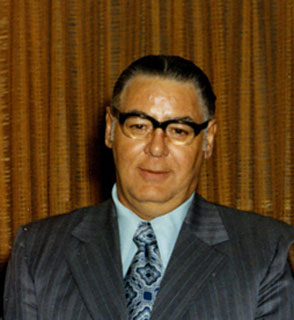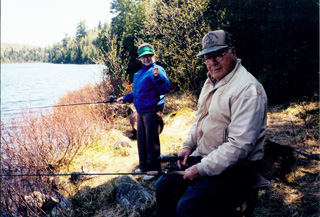Bill Amyotte: "We'll Be In It."
With storm clouds gathering over Europe, the United States took the cautionary measure of instituting the first peacetime military draft in its history in 1940. Young men from all over Minnesota answered the call to arms, including many American Indian men. Bill Amyotte of Grand Portage, Minnesota sensed that his country would soon be at war, and enlisted in July 1940, before the draft began. Mr. Amyotte spent time training at Fort Snelling and Fort Lewis, Washington before being sent to Alaska in 1941. He remembered his reasons for joining up and his early Army experiences in a 2006 interview with Karissa White and Brian Horrigan, excerpted below.
Oral History Excerpt
KW = Karissa White, BH = Brian Horrigan, BA = Bill Amyotte
KW: So you voluntarily enlisted?
BA: Yes. Enlisted July 19, 1940.
KW: So that was before Pearl Harbor.
BA: Oh, yes.
BH: Was it before the draft?
BA: Oh, yes. Yes.
BH: Because they started the draft in 1940. It was the first peacetime . . .
BA: That was later on.
BH: Like September maybe. Yes. First peacetime draft. So you must have heard something was going on.
BA: Yes. It was about the time France was falling, and I figured that it won't be long and we'll be in it. So I thought I'd get in there and get some training before it actually started. And I had a brother Andrew who was eleven years older than me. He enlisted in June of 1940. He was at Seattle, Washington when he enlisted. So then when I enlisted I wanted to be in...told the recruiter that I want to fire the big guns. I don't want to monkey around with the little ones. So he said, "There's an opening in the 81st Field Artillery. It's mechanized artillery and it is stationed in Fort Lewis, Washington." So then I took my basic training in Fort Snelling and in August, the latter part of August, I was sent over to Fort Lewis. And my brother Andy, who enlisted in June, he was then what they called 99th Pack Artillery. Mule outfit. He wanted me to transfer into his outfit and I said no way. So then he transferred to my outfit as the first cook. And he was good. He was the cook. So then we were together for two and half years.
BH: What did the army do with mules?
BA: Pack artillery. They’d take the little guns, the cannons, apart. Little barrel on the tube about so long. Seventy-five millimeters. The recoil..we took the tube off and then the recoil would be on each side of a mule, wheels on another mule, trails on another mule. You could go any place you wanted.
BH: Took mules overseas?
BA: Oh, yes. Yes.
KW: When you enlisted you did your basic training at Fort Snelling for how long?
BA: Just about . . . not quite a month.
KW: A month. Okay. Then you went to Fort Lewis?
BA: Fort Lewis, Washington. I was there until March of 1941 and then we were sent to Alaska and we were up in Alaska before the war started. We were on alert there for...in July before the war started.
KW: How many men were there with you?
BA: At that time there were very few. When Japan invaded the Aleutian Islands through Attu, there was only about twenty-five thousand troops in all of Alaska. So when the war broke out there wasn't that many.
KW: What was your job up there? Specific job that you had to do.
BA: Mostly...I was in artillery to begin with and cook. Then I ended up as a mess sergeant. But I was on the line for quite a while. Firing the guns. Practice. The outfit I was in was seventy-five millimeters. B Battery of the 81st. And then C Battery was one-fifty-fives. We had one-fifty-five millimeters howitzers and we had one long tom OGPF with a sixteen-foot tube on it. So that would shoot for a long distance. The 4th Infantry Regiment was the ones backing us up, protecting us. Every artillery outfit has to have infantry with them to protect them. They were the 4th Infantry and they were dug in on...started in July of 1941. They were dug in the low range of hills around Anchorage. They were in there like moles.
KW: So you were close to Anchorage?
BA: Yes. Yes. Fort Richardson, Alaska. Elmendorf Airfield was our...
BH: This is before Pearl Harbor. But Americans must have sensed that they needed to protect the Pacific and Alaska.
BA: Oh, yes. Yes. Yes. They were...they'd sent us up there in March of 1941 saying that we were up there to test the recoil mechanism on our artillery pieces. Well, they knew what it was. That was not to let Japan know that we were starting to build up fortifications. When the war broke out, the day the war broke out I was...we had a little shack. My brother and I had a little shack about fourteen miles out of the post up on Eagle River and we'd go up there fishing every day...time we had off. Go up to the little shack and fish. And I happened to be up there during that time. It was about fourteen miles. You had to snowshoe across woods up to there. I was coming back and I was all by myself. Coming back, snowshoeing back, and where I always went by was the ammunition dump. And here the 4th Infantry was out there with a machine gun and wouldn't let me go by. I had to [prove to them] who the heck I was and I never had any identification on me. Finally they let me go by and then I'd always come...right [through] the middle of Elmendorf Field and I'd just walk across the runway into our barracks. There you couldn't because...so then I had to walk way down to the end. About a mile down to the end. Another mile back up.
BH: And that was because the war had broken out?
BA: Yes. The war had started that day. That's when the Japs bombed Pearl Harbor. Then we loaded up all of our equipment, went to our gun positions and we stayed there for a couple weeks. We'd have positions, like to blow up Murrow Field. That was a civilian airport. Another position to blow up the ports, all the wharves and so on. And then different radio stations and stuff like that to keep from them from going to the Japs' hands. The radio stations, what I'm talking about is the beams for guiding airplanes. They had beams all the way across Alaska for the airplanes to follow. So we had to blow those up.
BH: You blew them up?
BA: We would if the Japs landed.
BH: Oh, I see. You weren't doing it preemptively.
BA: Oh, no. No. No. Then we had different shells if the Japs came in to shell us from submarines. We had...shells that would go underwater and then explode. For the submarines...
KW: I have a question. I want to back up just a little bit. The reason why you enlisted. You said that there was some feeling that Americans were going to be drawn into the war eventually. Was anybody ever opposed to that or what did they think about that? About being drawn into the war.
BA: There was none that I knew of that was against it. I never...there was a lot of talk about it. And around the area, around Caldwell, there was a lot of Norwegians and that was about the time Norway fell, too, to the Germans.
BH: Yes. 1940.
BA: But it was just the idea in my own mind that we'd be drawn into it.
Source
Bill Amyotte; Karissa White and Brian Horrigan, Interviewers, Minnesota's Greatest Generation Oral History Project, Minnesota Historical Society Oral History Collection, 2006.




